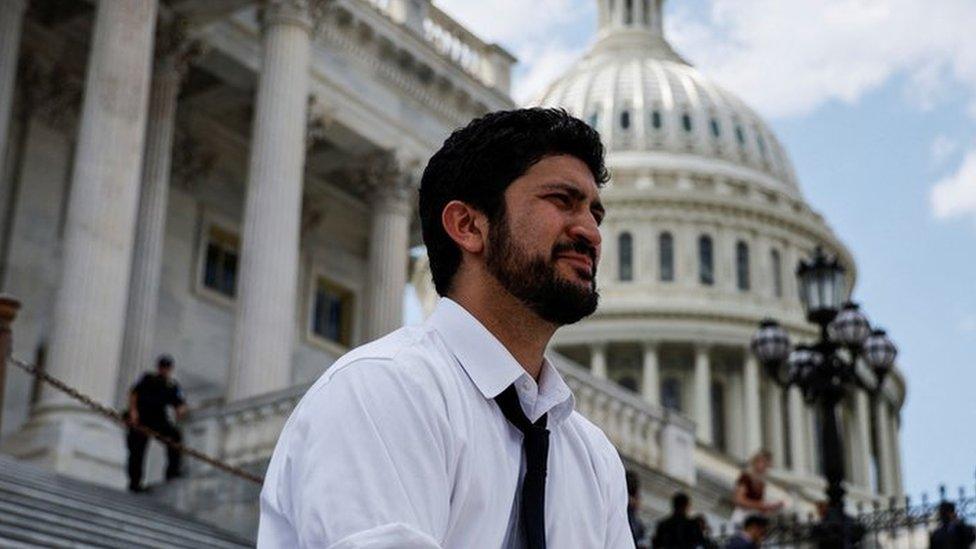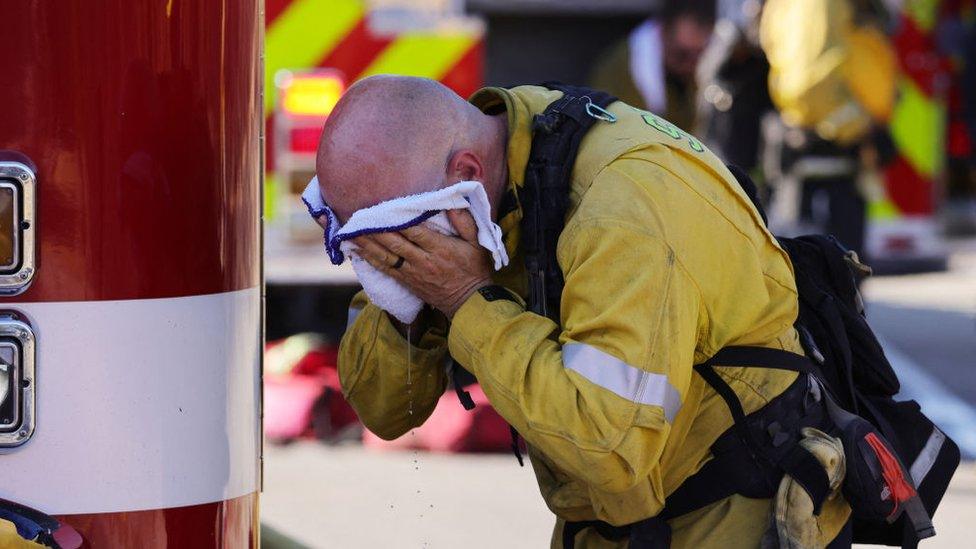US heatwave: Joe Biden announces measures to tackle extreme temperatures
- Published
Heatwaves: Are lower temperatures around the corner?
US President Joe Biden has announced measures to try to tackle the effects of extreme heat as 180 million Americans are under heat watches and warnings.
Major cities including Boston, Philadelphia, and Washington DC, were under heat emergencies on Thursday.
The striking actors' union Sag-Aftra was forced to pause picket lines amid New York City's excessive heat warning.
The extreme heat is expected to last through the weekend.
"I don't think anybody can deny the impact of climate change anymore," President Biden said on Thursday at a White House press conference.
He unveiled new measures designed to help workers most vulnerable to heat, increase funding for weather forecasting, and expand water storage capacity in the western states.
He also said the US Forest Service will award more than $1bn (£781m) in grants to help cities and towns plant trees, which can help lower temperatures in urban areas significantly.
Mr Biden said heat is the "number one weather-related killer" in the US, causing 600 deaths each year.
"The construction workers who literally risked their lives working all day in blazing heat, and in some places don't even have a right to take a water break, that's outrageous," he said.
Earlier this week, Texas Congressman Greg Casar held a food and water strike to protest against a Texas law overriding protection for people working outdoors in intense heat.
He cited the death of a 40-year-old postal worker who died on his route, and a 35-year-old believed to have died of heat exhaustion while working to restore power in Texas' Harrison County.
San Antonio Mayor Ron Nirenberg and Phoenix Mayor Kate Gallego joined Mr Biden at the event virtually on Thursday.
Mayor Gallego said: "Phoenix is on the front line of climate change."
She has been pushing for Congress to pass a bill adding extreme heat to the Federal Emergency Management Agency (Fema)'s list of major disaster qualifying events, which would aid response funding.
Mayor Nirenberg told BBC News San Antonio had seen unrelenting heat for consecutive years and it was a new "reality that we're having to face and accommodate through smarter infrastructure".
He added that "heat related illness calls for emergency response are up 50% just this year".

Heat indices across the East Coast are reaching over 100F (38C)
Critics said Mr Biden's measures do not go far enough, and that while these measures are important, climate change will continue to worsen without addressing the use of fossil fuels.
Sweltering humidity is exacerbating the high temperatures in some parts of the US, increasing the heat index - or what the temperature feels like to humans when humidity is combined with the air temperature.
In Washington, DC, and New York City, temperatures are expected to feel like 107F (41C) and 105F (40C) respectively, on Friday.
One subway cleaning worker, Jessica, told the BBC on Thursday that "it feels like the world is ending".
Her job requires her to be in a non-airconditioned environment most of the time.
She said, "It's horrible, it's torturous. I try to take cooling and water breaks when I can."
East coast night-time lows between now and the weekend will be as much as 10 to 15 degrees Fahrenheit above average for the region, according to the National Weather Service (NWS).
The largest US power grid operator, PJM, issued a level one emergency on Thursday for the 13-state eastern US grid in anticipation of an increased demand for electricity.
Watch: The heat index explained in 90 seconds
And record-breaking heat continues to bake the Southwest and Central US.
Phoenix, Arizona, has now endured 28 consecutive days with the mercury at or above 110F (43C).
The evenings have offered little respite - overnight temperatures have not dropped below 90F (32C) for at least 16 days.
El Paso, Texas, has surpassed even Phoenix, hitting 42 consecutive days of temperatures at or above 100F (38C) on Thursday.
In addition to the scorching weather, some parts of the US are facing intense thunderstorm systems.
Some 180,000 people are without power in Michigan after a storm soaked the region and downed power lines on Wednesday.
The Upper Midwest and Great Lakes are forecast to get more thunderstorms, which could bring 75-mph winds and golf-ball-sized hail, on Thursday afternoon into Friday.
Those storms will then spread into the Northeast and Mid-Atlantic late Friday into Saturday, the NWS predicts - bringing damaging winds, hail and possible flash flooding.
Related topics
- Published26 July 2023

- Published25 July 2023

- Published24 July 2023

- Published24 July 2023
